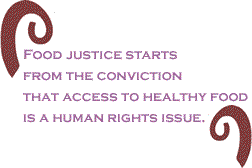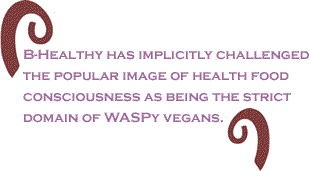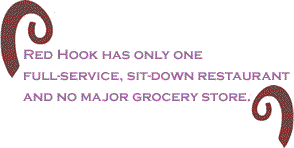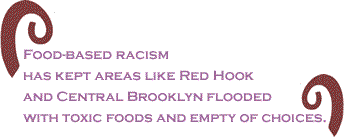
|
|||||||||||||||||||||
 |
The following article was originally published in Gotham Gazette, a publication of the Citizens Union Foundation. One
of the great, often unspoken, forms of oppression that low-
and moderate-income
communities suffer through is the lack of access to healthy
food. When I moved back to Central Brooklyn in 1985, I was
struck by its barren nutritional landscape. It wasn’t just
that options like fresh produce and organic foods were hard
to come by. But the storefront food provision systems themselves – "bullet-proof" fast
food joints, poorly stocked and over-crowded supermarkets,
cruddy, stomach-curdling bodegas – seemed to represent a level
of self-destruction and dietary corruption that went well beyond
my inability to buy tofu on Nostrand Avenue. While most residents
and activists look at conditions such as public safety, housing
availability, public education, environmental concerns and
economic opportunities when taking on community development
issues, seldom do we consider one of the most basic elements – how
an area feeds itself – as a sign of neighborhood well being.
For its part, B-Healthy tries to offset the dominance of
processed foods and fast food advertising in the lives
of young people with political education
and a sort of counter-insurgency culinary training. With a curriculum that
includes books like Fast
Food Nation, Diet
for a Small Planet and Food
Fight, B-Healthy offers everything from cooking classes to tips on
how to shop for pesticide-free, non-genetically modified foods.
Just Food,
which has integrated a social justice mission into its
name, has been the catalyst for the establishment of 30
CSAs – Community Supported
Agriculture – throughout the city, some in areas like Harlem, Bushwick
and East New York. CSAs are arrangements in which people living in
a given area purchase "shares" of organically-grown produce
directly from local sources. CSAs provide urban families with more
healthy eating choices, while also supporting family-run farms. Just
as importantly, CSAs, like other local food systems, eliminate a
neighborhood’s dependence on far-flung corporate growers
and a host of intervening processors, handlers, distributors,
transporters and
other middle people who have made the business of connecting
urban America to food inefficient and environmentally taxing.
One text book example of a project that seeks to address
a range of community needs through food activism has recently
taken root
in Red Hook, a mostly
low-income neighborhood with a food terrain that is decidedly
user-hostile. According to Ian Marvy, co-director of Added
Value, Red Hook has only one full-service, sit-down restaurant
and no major grocery store, but is otherwise replete with bodegas,
steam line eateries,
pizza shops and fried chicken shops. On real estate that is
being eyed by hungry developers seeking new water front opportunities,
Added Value
and
a cadre of young people from the surrounding area maintain
a
modest farm with other local farmers and run a market where
young people
sell the farm’s
collective harvest, as well as beef, chicken and fish from
other local farms. Added Value is also making plans to build
a green
house and harvest fish
itself.
Still, some are hinting at a slightly more aggressive march
towards progress. Terry sees the young people he works
with as one day creating
community organizing
campaigns. He looks to take on the perpetrators of structural,
food-based racism that, he feels, has kept areas like
Red Hook and Central Brooklyn
flooded with toxic foods and empty of choices. Of course,
these days, racism is often easier to feel than prove.
And while the economic development and
food distribution visions of Terry and his peers are
clear, a strategy of what public policies would be targeted
by food-centered, grassroots organizing
campaigns is far less so. Any way you look at it, America’s appetites for
fast food and corporate farming – both defining aspects of American culture – are
not retreating anytime soon.
New social realities always begin here, as somebody’s seemingly far-fetched
dreams. In the meantime, I’m itching for a food fight.
|
December
25, 2003 |
||||||||||||
|
||||||||||||
|
|
||||||||||||
| Printer Friendly Version | ||||||||||||
| |
||||||||||||
| |
||||||||||||





























